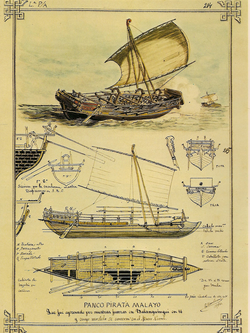Banguingui people
This article needs additional citations for verification. (December 2008) |
| Total population | |
|---|---|
| 84,000 Austronesian peoples |

Banguingui, also known as Sama Banguingui or Samal Banguingui (alternative spellings include Bangingi’, Bangingi, Banguingui, Balanguingui, and Balangingi) is a distinct ethnolinguistic group native to
Sama-Bajau peoples
.
People
The Banguingui are not officially recognized by law either in the Philippines or in the neighboring Malaysian state of Sabah.
The Banguingui language has both written and oral traditions. Its written language is in Jawi script and is fast becoming a dying tradition. Oral traditions are handed down by the kamattoahan (elders) to the kaanakan or anak baha-u (new generations).
The Banguingui built kuta (forts) throughout the
piracy and the slave trade during the 18th and 19th centuries. The Banguingui usually sailed garay warships, in contrast to the lanong of the Iranun.[2]
Notable Banguingui
- Maas Alidji – a mariner in the service of the Sultan who gain fame during a battle in Brunei Bay.
- Maas Arolas Tulawie – one time governor of the Province of Sulu and patriarch of the Tulawie Clan. His descendants include some of the political leaders in the province. Their bailiwick is the Municipality of Talipao in the eastern region of Jolo Island.
- Balimbing (now Panglima Sugala).
- Panglima Alip - Progenitor of the Tulawies of Sulu and Diongas of Tawi-Tawi, was overlord of Tongkil in the 19th century reporting directly to the Sultan of Sulu.
See also
- Spanish expedition to Balanguingui
- Ethnic groups in the Philippines
- Iranun people
- Garay (ship)
- Karakoa
